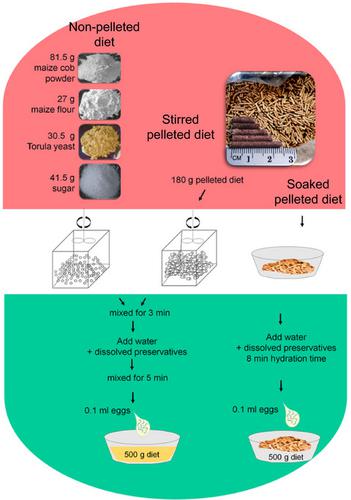当前位置:
X-MOL 学术
›
Entomol. Exp. Appl.
›
论文详情
Our official English website, www.x-mol.net, welcomes your
feedback! (Note: you will need to create a separate account there.)
Evaluation of a pelleted diet for larval mass‐rearing of Anastrepha ludens and Anastrepha obliqua
Entomologia Experimentalis et Applicata ( IF 1.4 ) Pub Date : 2020-04-16 , DOI: 10.1111/eea.12903 Marysol Aceituno‐Medina 1 , José Pedro Rivera‐Ciprian 2 , Emilio Hernández 1
Entomologia Experimentalis et Applicata ( IF 1.4 ) Pub Date : 2020-04-16 , DOI: 10.1111/eea.12903 Marysol Aceituno‐Medina 1 , José Pedro Rivera‐Ciprian 2 , Emilio Hernández 1
Affiliation

|
Most artificial diets used for mass‐rearing of fruit fly larvae involve the purchase and independent weighing of each ingredient of the formulation, followed by mixing and diet preparation process. A ready‐to‐use formulation would avoid this time‐consuming task and simplify the preparation procedure, leading to a more standardized diet. In this work, we compared life‐history traits and survival and developmental parameters of Anastrepha ludens Loew and Anastrepha obliqua (Macquart) (Diptera: Tephritidae) reared on two formulations of an artificial diet. Two experiments were performed; first, a conventional non‐pelleted diet was compared to a newly developed pelleted diet, which was mixed with water before being given to the larvae. The second experiment consisted of a comparison between the pelleted diet which was stirred in a mixer with water and dissolved preservatives and a pelleted diet which was only soaked in water with dissolved preservatives. We found that the pelleted diet allowed the mass‐rearing of A. ludens and A. obliqua. Moreover, feeding larvae with pelleted diet led to increased weight of the larva by 7.4 and 11.8%, and of the pupa by 9.5 and 16.7% for A. ludens and A. obliqua, respectively, compared to conventional diet. For process evaluation, the number of activities, handling time, reception, storage, and larval diet preparation were recorded. The pelleted diet only needed soaking in water containing preservatives, thereby simplifying the mass‐rearing process and saving time, space, and labour. Pelletizing is a versatile technology that can be adjusted for better physicochemical quality and reduced microbiological risk. This diet should be of particular interest for the mass‐rearing process in ‘sterile insect technique’ applications.
中文翻译:

颗粒饲料对白实实蝇和斜实实实蝇幼虫大量饲养的评价
大多数用于大规模饲养果蝇幼虫的人工饲料涉及购买和独立称量配方中的每种成分,然后是混合和饲料制备过程。即用型配方将避免这项耗时的任务并简化准备程序,从而实现更标准化的饮食。在这项工作中,我们比较了用两种人工饲料配方饲养的白实实蝇和斜实实实实蝇(Macquart)(双翅目:实蝇科)的生活史特征以及生存和发育参数。进行了两个实验;首先,将传统的非颗粒饲料与新开发的颗粒饲料进行比较,颗粒饲料在喂给幼虫之前与水混合。第二个实验包括在混合器中与水和溶解防腐剂一起搅拌的颗粒饲料与仅浸泡在含有溶解防腐剂的水中的颗粒饲料之间的比较。我们发现颗粒饲料允许大量饲养 A. ludens 和 A.obliqua。此外,与常规饮食相比,用颗粒饲料喂养幼虫导致幼虫体重增加 7.4% 和 11.8%,而 A.ludens 和 A.obliqua 的蛹体重分别增加 9.5% 和 16.7%。对于过程评估,记录活动次数、处理时间、接收、储存和幼虫饮食准备。颗粒饲料只需要浸泡在含有防腐剂的水中,从而简化了大规模饲养过程,节省了时间、空间和劳动力。造粒是一种通用技术,可以进行调整以获得更好的物理化学质量并降低微生物风险。这种饮食应该对“不育昆虫技术”应用中的大规模饲养过程特别感兴趣。
更新日期:2020-04-16
中文翻译:

颗粒饲料对白实实蝇和斜实实实蝇幼虫大量饲养的评价
大多数用于大规模饲养果蝇幼虫的人工饲料涉及购买和独立称量配方中的每种成分,然后是混合和饲料制备过程。即用型配方将避免这项耗时的任务并简化准备程序,从而实现更标准化的饮食。在这项工作中,我们比较了用两种人工饲料配方饲养的白实实蝇和斜实实实实蝇(Macquart)(双翅目:实蝇科)的生活史特征以及生存和发育参数。进行了两个实验;首先,将传统的非颗粒饲料与新开发的颗粒饲料进行比较,颗粒饲料在喂给幼虫之前与水混合。第二个实验包括在混合器中与水和溶解防腐剂一起搅拌的颗粒饲料与仅浸泡在含有溶解防腐剂的水中的颗粒饲料之间的比较。我们发现颗粒饲料允许大量饲养 A. ludens 和 A.obliqua。此外,与常规饮食相比,用颗粒饲料喂养幼虫导致幼虫体重增加 7.4% 和 11.8%,而 A.ludens 和 A.obliqua 的蛹体重分别增加 9.5% 和 16.7%。对于过程评估,记录活动次数、处理时间、接收、储存和幼虫饮食准备。颗粒饲料只需要浸泡在含有防腐剂的水中,从而简化了大规模饲养过程,节省了时间、空间和劳动力。造粒是一种通用技术,可以进行调整以获得更好的物理化学质量并降低微生物风险。这种饮食应该对“不育昆虫技术”应用中的大规模饲养过程特别感兴趣。









































 京公网安备 11010802027423号
京公网安备 11010802027423号